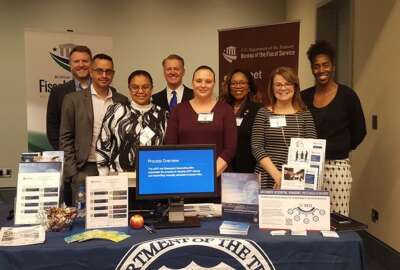
New chief innovation officer to help FDIC shape future of financial sector
Sultan Meghji, Federal Deposit Insurance Corporation’s new chief innovation officer, is developing his roles and responsibilities as he shapes this position.
Best listening experience is on Chrome, Firefox or Safari. Subscribe to Federal Drive’s daily audio interviews on Apple Podcasts or PodcastOne.
The Federal Deposit Insurance Corporation’s new chief innovation officer spent his entire career in technology before joining the government.
But as a different kind of C-I-O, Sultan Meghji will apply that technology experience in another way.
Meghji said he’s starting with a blank sheet of paper, in many respects, as he develops the mission and focus areas of FDIC’s new the chief innovation officer (CINO).

“The chief innovation officer role is not predominantly technology, it is a role designed to run the tech lab, and to a degree centralize and coordinate all of the different innovative functions, not just internally, but also externally with the market,” Meghji said in an interview with Federal News Network. “I’m going to look at all of the different things going on in the market, all of the changes that are happening, the impact of the pandemic, the impact of digital banking, financial technology, and figure out how to bring it into the FDIC and drive it so that we continue to ensure that the banks of the United States ensure they’re run safely and soundly, but then also ensure that they’re inclusive for the entire American population.”
Over the years, agencies have brought in this new kindf CIO, but many have been focused internally on how to bring innovation to the agency mission areas. A 2019 report from the Institute for Defense Analyses found CINOs work to harness, foster, execute and manage innovative ideas so that they can be effectively executed to create impact and value for the organization.
But the FDIC and other financial agencies like the Commodity Futures Trading Commission (CFTC) and the Federal Reserve are focused externally to a large extent.
The CFTC CINO runs the LabCFTC and is taking a multi-pronged approach to finding and promoting innovation in the financial sector.
Meghji said he believes his role will be both external and internal, but is unsure whether one will be more dominant over the other.
Meghji comes to the FDIC after spending his career in technology and the financial sector. He was the CEO and founder of Neocova, a financial technology firm providing secure cloud, artificial intelligence-based software for community banks and credit unions. He also worked on an aid mission to help implement digital banking in Kenya, Tanzania and Uganda and worked with fintechs and central banks to create peer-to-peer banking systems in underserved areas of Africa and Central Asia.
Tapping into existing innovations
These experiences drew Meghji to the FDIC.
“What we did do was, and this was part of the way we grew Neocova, was to be what we call the regulatory forward. Years ago, I started spending a decent amount of time at the state level and at the federal level working within the regulatory community. I think a lot of fintechs would be more successful if they did that,” he said. “For Neocova, it was a key indicator of success because by doing that, it did definitely create the relationships and begin some of those discussions.”
Meghji plans to takes those relationships, which started in the private sector, and lean on them as he begins his public sector career. He recognizes that there is a lot of innovative and game-changing work already in progress across the financial sector and would like to tap into it.
“The biggest thing for me is understanding how we can move the needle in the most impactful way, in the most secure way, and then the most in the least friction kind of way. The downstream effects of the pandemic have resulted in one of the largest digital transformation programs in the banking sector in history. The move away from branch style activities to digital activities. If you look at how the paycheck protection program (PPP) was rolled out mostly out of the community banking sector and what how they used fintechs to support that in some cases, and in other cases, they had people working three shifts,” he said. “We need to think through how we can have those positive impacts not just to deal with the tactical issues of today, but also the more strategic issues in the future. This is not going to slow down, these kinds of changes to our culture are not going to go away overnight, and certainly probably in many cases, it will go away at all. For us, it’s about maintaining the safety and security in the face of these changes, in the face of an increased focus on cybersecurity, which we of course have to have, but also in a place where we need to continue to drive more aggressively inclusion across the underserved members of our of our of our citizenry.”
One of those ways that the FDIC can reduce friction in the banking sector is through automation and increased use of robotics process automation tools.
Incentivizing the right behaviors
Meghji said this will increase both the resilience of the system but also help financial sector workers move away from the low-value, menial tasks that often come with financial management.
“Whether or not we’re talking about artificial intelligence writ large, or machine learning or a variety of other algorithms, we could choose, thoughtful enterprise technology design will allow us to alleviate a lot of that. I would be much more interested in seeing kind of larger scale technical architectures that build in more efficiency, more analytics, more predictive activity, more teachable activity and make sure that it’s explainable and thoughtful,” he said. “This is the exact same question that I’m asking in terms of what are we able to what are we able to do to really drive some value to the system?”
Meghji added these efforts also will help incentivize the right behaviors in the banking sector to address a growing host of challenges.
“I’ll talk about themes. I’ll talk about resilience. I’ll talk about inclusion, I’ll talk about friction. These are all things where we’ve got to move the needle on stuff,” he said. “Whether we’re talking about something very specific from an internal perspective that maybe comes up with something new and interesting that we need at the FDIC, or it’s something that we encourage or incentivize in the market, like what we’re doing with our Rapid Phased Prototyping (RPP) program. There are a couple of different ways we can approach that.”
The list of possibilities is long but what matters is figuring out what’s most impactful, what can be executed in a reasonable amount of time and what positions the banking sector for the future, he said.
“The last thing I would want to do is do a bunch of tactical innovation work that doesn’t solve these bigger strategic questions that will continue to come over time,” Meghji said. “So you’ll see a strategic view to this before you necessarily start seeing a lot of tactical stuff.”
Copyright © 2025 Federal News Network. All rights reserved. This website is not intended for users located within the European Economic Area.
Jason Miller is executive editor of Federal News Network and directs news coverage on the people, policy and programs of the federal government.
Follow @jmillerWFED
Related Stories





